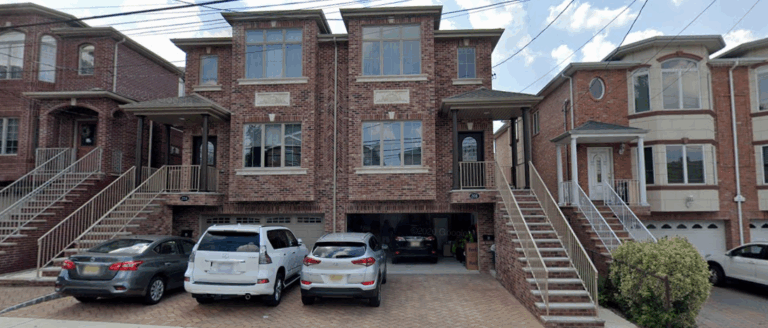Physical Address
304 North Cardinal St.
Dorchester Center, MA 02124
Physical Address
304 North Cardinal St.
Dorchester Center, MA 02124

In two previous posts, I’ve raised questions about the competitiveness of missing middle housing. This post is more petty: I want to challenge the design rigidities that Daniel Parolek promotes in Missing Middle Housing. Although petty, it’s not irrelevant, because Parolek recommends that cities regulate to match his design goals, and such regulations could stifle some of the most successful contemporary infill growth. Parolek’s book suffers from his demands that missing middle housing match his own tastes. For instance, he has a (Western?) bias against three-story buildings. Having grown up in the Northeast, I think of three stories as the normal and appropriate height for a house. To each his own – but Parolek’s constant insistence on this point offers aid to neighborhood defenders who will be happy to quote him to make sure three-story middle housing remains missing. The house in the doghouse No form is in Parolek’s doghouse as much as the “tuck-under” townhouse, an attached house with a garage on the first floor. This is clearly a building that builders and buyers love: “If your regulations do not explicitly prohibit it, it will be what most builders will build” (p. 140). In fact, tuck-under townhouses are probably the most successful middle housing type around. In lightly-regulated Houston, builders small and large have been building townhouses, sometimes on courtyards perpendicular to the road. Parking is tucked. Townhouses are usually three stories tall (bad!), sometimes four. A few are even five stories. Their courtyards are driveways (also bad!). In a very different context – Palisades Park, NJ – tuck-under duplexes are everywhere. Their garages are excessive thanks to high parking minimums, but the form has been very successful nonetheless. These examples are not to be dismissed lightly: these are some of the only cases where widespread middle housing is […]

The Center for Market Urbanism released its first policy report in partnership with Abundant Housing Los Angeles. The paper, written by The Center for Market Urbanism’s Nolan Gray and Emily Hamilton, recommends eliminating minimum parking requirements as part of DTLA 2040, a process which will update both the Central City and Central City North community plans. The draft concept for the DTLA 2040 plan calls for eliminating parking requirements for the Central City and Central City North neighborhoods. This would build upon the success of Los Angeles’ adaptive reuse, allowing new developments to facilitate affordable, dense, walkable neighborhoods. The paper discusses the history of parking requirements, burdens and damage caused by current parking requirements, and benefits of reforms: Combined with demand-based pricing for on-street parking, the elimination of parking requirements will allow for downtown neighborhoods that are more walkable while also reducing congestion for drivers. Read the Center for Market Urbanism/Abundant Housing LA Policy Paper here The Center for Market Urbanism is a 501c3 organization dedicated to expanding choice, affordability, and prosperity in cities through smart reforms to U.S. land-use regulation. Abundant Housing LA is 501c3 organization which is committed to advocating for more housing. We want lower rents and a more sustainable and prosperous region, where everyone has more choices of where to live and how to pursue their dreams. LA is one of the most diverse, vibrant cities in America, and we are fighting to keep it that way for current Angelenos, our children, and those who come here to pursue their dreams.
[This post was originally published on the blog Better Institutions] The people who live in coastal urban cities tend to be a pretty liberal bunch. We’re leading the country on minimum wage laws, paid sick leave, climate change mitigation, and a host of other important issues. We care deeply about equality of opportunity, and we’re willing to invest our time and money to advance that effort—even if the people we help don’t always look like us or come from the same neighborhood, state, or even country. I’m proud to count myself among their number. And then we turn to housing. Maybe it’s just because we’re doing great on so many other fronts, but when I look at our inability to solve the housing crisis in places like San Francisco, New York, and Washington, D.C., I’m left feeling nothing but depression and hopelessness. It’s all the more frustrating because unaffordable housing might be the most important economic problem facing residents of liberal U.S. cities, and we’re perfectly, comprehensively, and unmistakably blowing it. The causes of this failure are too numerous to ever fully enumerate in a single blog post, and, admittedly, some are out of the hands of cities themselves. But I don’t want to be too forgiving—state and federal policy plays a role, for example, but liberal U.S. cities are also typically located in liberal U.S. states, and federal policy applies equally to all, including the cities that have managed to remain affordable. There’s also the impact of global capitalism on a few world class cities, but it’s hard to feel genuine pity for places where foreign investors are willing to dump billions of dollars. Boo-hoo. At it’s heart this is a problem of liberal governance and/or policy, and we need to face it head on. We can’t blame this on someone else. It’s our […]

[This piece was originally published on the site Better Institutions.] On March 7th, Los Angeles is going to vote on the type of city it wants to be. The vote will be over Measure S, formerly known as the Neighborhood Integrity Initiative (NII), which seeks to limit housing development in the city. Backers of the initiative claim that City Council is too beholden to developers, and that the pace of new housing and commercial development in the city is out of control. They also express concern that “mega projects” are making Los Angeles less affordable, since few new homes are being targeted at low and moderate income households. It’s a really bad plan, but calling Measure S “bad” doesn’t go nearly far enough. It is, in fact, the Donald Trump of ballot initiatives. It’s a cynical effort to co-opt a legitimate sense of frustration—frustration felt by those who haven’t shared in the gains of an increasingly bifurcated society—and to use that rage and desperation for purely selfish purposes. It invites us to vent our frustrations and, in so doing, to further enrich those who helped to engineer our ill fortune. And as with Trump, a Measure S victory will roll back the clock on years of steady progress. Since I think there are a lot of folks out there who genuinely haven’t made up their minds about the initiative, or aren’t yet familiar with it, I’d like to summarize some of the most important reasons to oppose it when it comes time to vote this March. 1. IT WILL MEAN FEWER AFFORDABLE HOUSING UNITS FOR LOW INCOME HOUSEHOLDS. The Coalition to Preserve LA, which is backing the initiative, is turning this into a referendum on housing development in Los Angeles. They’re arguing that new homes have “wiped out thousands of […]